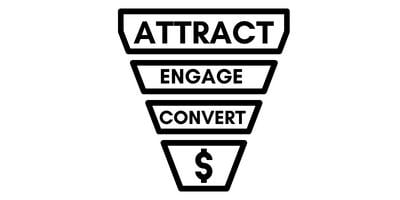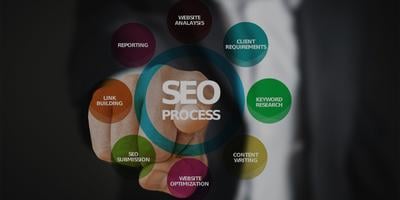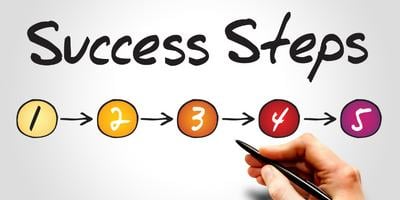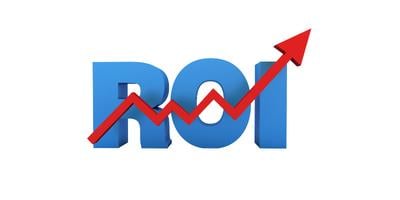How Inbound Marketing Can Grow Your B2B Business Quickly and Easily

Table of Contents:
Elements of an Inbound Marketing Strategy
Creating and Executing an Inbound Campaign
Measuring Your Inbound Strategy ROI
Combining Inbound and Outbound Marketing
Conclusion and Benefits of Inbound Marketing for B2B Businesses
Responses to Frequently Asked Questions with Detailed Explanations
If you're a B2B organization looking to scale with less stress and more success, here's a little secret: Inbound marketing can help you do it. So many businesses hear inbound marketing and immediately get overwhelmed by the work it implies. But don't worry, because in this blog post, we'll explore how this efficient marketing method can quickly and easily help you reach your goal of growing and sustaining your business. Once you understand the basics of inbound marketing, you'll be ready to strengthen your online presence and increase conversions faster than you can say "hooray!"
Quick Clarification of Key Points
Inbound marketing provides an effective strategy to attract potential customers and build trust by providing helpful content that adds value. It is also cost-effective, able to extend a business' reach through organic search engine rankings and social media promotion.
What is Inbound Marketing?
Inbound marketing is a method of marketing that focuses on drawing customers and prospects to your business through helpful, educational content. This approach to marketing allows businesses to strengthen their customer relationships and increase profitable outcomes. The goal of inbound marketing is to create high-quality content that provides answers to the questions posed by potential customers and helps them make informed buying decisions. Donovan Digital Solutions is an expert in answering these questions through Inbound marketing tactics.
Inbound marketing revolves around three key elements: attracting visitors, engaging with customers and driving conversions. Donovan Digital Solutions has found that by providing valuable content, such as blog posts or case studies, businesses can attract potential customers who are interested in their services or products. Once those visitors are hooked, companies can engage with them further by providing additional helpful information and responding to any inquiries they may have. Finally, businesses use powerful analytics tools to measure the success of inbound campaigns and find ways to maximize their ROI (return on investment).

Proponents of inbound marketing argue that it can provide a steady stream of cost effective leads that can be nurtured and converted into long-term customers in any niche. With proper execution, businesses can generate qualified leads more efficiently than traditional outbound tactics like cold calling or direct mail advertisements. Others point out that while inbound marketing takes more effort upfront, it can pay off exponentially with higher returns from conversions and subsequent sales.
On the other hand, some argue that an inbound marketing strategy requires consistent time, attention and dedication for the long-term approach to achieve desired results; otherwise companies will not reap the rewards associated with this type of marketing tactic. Others caution that investing so much time into creating content requires a certain level of skill which is not easily attainable by teams with limited resources or experience in publishing. If this is the case with you, hiring a marketing agency may be an effective way to get exposure to inbound marketing strategies with minimal time commitment on your end.
Although there are pros and cons to each approach, it's clear from industry trends observed by Donovan Digital Solutions that inbound marketing continues to grow as a preferred method for engaging online customers and driving conversions. As such, many companies recognize the importance of utilizing inbound techniques as part of a larger digital marketing strategy. Now let’s dive into how you can leverage targeted content for greater growth with inbound marketing.
Leverage Targeted Content
Content plays an important role in any successful inbound marketing strategy. When targeting and engaging your B2B audience, it is important to leverage targeted content. Targeted content helps you reach the right people at the right stage of their buyer's journey with effective messages that they want and need to see.
By focusing narrowly on specific personas and industry-specific interests, you can use targeted content to move prospects toward conversion. This type of content may include white papers, webinars, blog posts and short videos, each with their own distinct goals. Defining your goals and knowing what type of content will resonate the most positively with your audience is key and requires continuous monitoring and analysis. Doing so means adjusting your content sails depending on customer responses and preferences.
Furthermore, creating irresistible content takes more than just writing compelling copy; you must also ensure that your message accurately reflects customer interests at the the right stage of the buyer's journey while remaining visually appealing. Blogging with creative visuals – such as infographics – can be especially helpful in driving engagement with potential customers by establishing yourself as a credible authority with timely, relevant information.
Lastly, targeted content can also prove to be an effective tool for businesses to create meaningful connections with consumers and drive brand loyalty, as customers are more likely to stay engaged when they feel personally addressed by a brand's messaging. By combining all the elements of content creation - quality writing, strategic positioning, continuous optimization and visual impact - businesses can benefit from having an effective integrated roadmap that strategically converts leads into loyal customers over time.
By leveraging targeted content strategically, businesses can quickly and easily tap into their target market for increased growth opportunities. The next section of this article will discuss how connecting with customers online is a key way to drive even greater business success through inbound marketing efforts.
Essential Summary Points
Content is an important part of a successful inbound marketing strategy for B2B businesses. For success, content should be tailored to the buyer's journey, specific personas and interests of prospects to drive conversions. Content must be both compelling and visually appealing, and should address customers personally to build loyalty and trust. Quality writing, positioning, optimization, and visuals need to be combined for an effective roadmap that converts leads into customers. By leveraging targeted content well, businesses can tap into their target market for increased growth opportunities.
Connecting with Customers Online
Connecting with customers online is at the heart of any successful inbound marketing strategy. By using digital channels to communicate and interact with prospects and customers, businesses can build stronger relationships and cultivate more loyal customers. Offering customers a robust online community is one way to engage them. This could involve a blog, live chat, email newsletters, or discussion forums, where people can come together to share experiences and develop relationships. Establishing an online presence is also key; doing this through social media platforms like Facebook and Twitter will not only help you reach new potential audiences, but also allow for quick feedback from customers about your product or service.
It's important to be aware that an online presence can also come with drawbacks. Without the necessary safeguards in place—for example, policies outlining how customer data should be managed—businesses risk breaching customer privacy laws, or exposing their data or business information to malicious actors. Additionally, anything posted online can be quickly shared beyond its initial audience and companies should be prepared for potentially negative responses from customers that may damage their reputation if not managed appropriately.
These potential risks associated with connecting with customers online make it essential for any B2B business to have clear policies in place outlining what acceptable behavior is and how customer data should be stored and handled securely when they are interacting with customers online.
Having addressed the pros and cons of connecting with customers online, it’s time to turn attention towards the other core elements of an inbound marketing strategy – determining who your target audience is and what content you need to deliver to engage them most effectively.
Elements of an Inbound Marketing Strategy
When it comes to developing a successful inbound-marketing strategy, there are several elements that businesses need to consider. First and foremost, an effective strategy begins with keyword research. Understanding what terminology is being used by customers in different stages of the buyer's journey when searching and researching online solutions related to your business is key to success.Utilizing the most relevant “long-tail” keywords will obviously pay off when it comes to SEO. Tools for Keyword research can be expensive and hard to use, It can be beneficial to leverage the tools and expertise of marketing agencies such as Donovan Digital Solutions in such research. Donovan Digital Solutions leverages tools such as Ahrefs, SEMrush and Moz to conduct thorough keyword research. Additionally, keyword research can show businesses which terms may be strategically important for driving search engine traffic. This will help you construct content topics and titles that more accurately reflect customer language within the industry.
The next key element of any inbound marketing strategy involves content production — utilizing blog posts, videos, infographics, images, and other forms of media to drive website traffic. Through the use of these combined resources, you can begin to establish thought-leadership and authority in your industry and cut through the noise of competitors who are doing similar things but with only mediocre results. Content production also helps ensure that potential customers land on pages from your site which boast helpful information for the right stage of the buyer's journey.
When it comes to airing out this content for public consumption, developing multifaceted social media campaigns must be taken into consideration as part of the overall inbound-marketing picture. Not only should you incorporate hashtags when possible to make your posts easily searchable by others, but you should definitely engage in timely conversations so people feel like they are a part of something bigger than just reading what you have written or posted on a timeline. The idea here is to enter into dynamic conversations whereby everyone involved feels heard, appreciated, and respected. This combined effort can help build relationships with leads over time and generate conversions more quickly and easily down the line as well.
Lastly, an effective inbound-marketing strategy revolves around tracking analytics (measurement) to gain insight into where improvements might be made going forward. Here again is another area where user feedback comes in handy when it comes to improving engagement on websites and across channels like social media.
In conclusion, while there are various components that go into creating a successful inbound-marketing strategy including keyword research, content production, productive social media campaigns, and strong analytics tracking; each individual component is equally as important if you want your B2B business to grow quickly and easily over time.
Now that we've covered all the basics it's time to move on and examine how website content plays an integral role in an effective inbound marketing strategy...
Website Content
Website content is one of the primary ways that you can use inbound marketing to grow your B2B business quickly and easily. It involves creating helpful and informative content for your website that provides value to both potential customers and existing customers. For example, this could include educational blog posts, whitepapers, product demos, webinars, and more.
When it comes to website content, there’s a delicate balance between quantity and quality. On the one hand, it’s important to post engaging content regularly in order to attract new prospects and keep your existing clients engaged. However, if you post too much content, you run the risk of overwhelming visitors with too much information and diminishing its value overall. The right approach is to maintain a steady cadence of quality content that is tailored to the needs of your specific target audience.
Another issue to consider when it comes to creating website content is who will be responsible for creating it. You may choose to create all the content yourself or you can outsource some or all of it. Depending on your budget and resources, outsourcing may be a great option as it can help ensure that the quality of your content remains high while also freeing up time for other aspects of running your business. Producing quality content is a great way to bring in organic cost effective leads.
By investing in website content that is tailored to the needs of your target audience and the buyer's journey you can establish credibility and trust with potential customers which will make them more likely to convert into paying customers. Ultimately, by taking the time to create quality website content, you will be able to reach more people, engage them with valuable information about your business and drive sales from qualified leads over time.
Now moving on from website content, let's discuss another important aspect of inbound marketing: search engine optimization (SEO).
Search Engine Optimization
If done correctly, Search Engine Optimization (SEO) can be an important and cost-effective form of marketing that helps businesses build visibility and attract qualified website visitors by increasing their visibility on search engines such as Google and Bing. SEO involves using relevant content, insightful keyword research, technical site optimization, and link building to improve organic rankings for target keywords. This can help businesses attract more potential customers with targeted and relevant content so they are in the right place at the right time to convert.

On one hand, SEO is a powerful tool that can increase website traffic quickly and dramatically. Search engine algorithms have become increasingly sophisticated over the years, so implementing effective optimization tactics can lead to dramatic results quickly. On the other hand, executing an effective SEO campaign is time consuming and requires specialized knowledge. It also takes time to generate results and it can be hard to track the return on investment (ROI). Outsourcing SEO can be one of the most beneficial areas of inbound marketing to outsource. Working with SEO experts such as the team at Donovan Digital Solutions can set you on the fast track to achieve your inbound marketing goals.
Therefore, while SEO can be a powerful marketing tactic for B2B businesses, it’s important to ensure you have realistic expectations about your ability to track ROI and implement tactics correctly. With a carefully planned SEO strategy in place, however, B2B businesses can expect to see improvements in their rankings and more potential customers visiting their websites. Donovan Digital Solutions has seen increased SEO performance in B2B such as Law, Payment processing and service by implementing inbound marketing strategies.
Having said that, SEO alone is not enough; in order to maximize growth potential all aspects of Inbound Marketing should be utilized including social media channels. The next section will address how B2B businesses can use social media channels to further grow their online presence with Inbound Marketing techniques.
Social Media Channels
Social media is a powerful tool in any business’s marketing repertoire, especially when it comes to the B2B market. It has grown into an essential part of any successful B2B outbound strategy, enabling businesses to quickly and easily reach far more potential customers than ever before.

When used effectively, social media channels can be used to gain valuable insights into your target market, enable one-to-one conversations about your brand, build relationships with potential customers and even create new customers. Many B2B companies use social media to keep their existing customers informed and up-to-date on the latest products and services.
The key to using social media successfully for B2B marketing is having a robust strategy that takes into account the different needs of businesses from different industries and regions. For example, if you are targeting businesses in a local area you may need to customize your content for the specific market and geographical area you are targeting.
That said, there are some that believe social media is not an essential element of a successful inbound marketing strategy. These people argue that as most B2B transactions take place offline, a strong presence on social media is unnecessary. While it’s true that most transactions do take place face-to-face or over the phone, B2B decision makers are increasingly turning to various online sources for information when making their purchasing decisions – particularly when researching potential suppliers or evaluating new products or services.Even so, imagine an inflow of leads that come in endlessly even while you’re working on closing deals offline. With an inbound marketing strategy your deal pipeline should never run out of leads.
In this way, social media provides an effective platform for sharing both general information and targeted offers related to your core products and services. Having a strong presence on social media networks shows customers that your business takes digital marketing seriously and demonstrates a knowledge of current market trends.
Ultimately, social media should form a key component of any effective inbound marketing campaign for any business looking to grow quickly and easily.
The next step in building an effective inbound marketing campaign is creating and executing an inbound campaign that utilizes multiple channels and resources like content marketing, SEO, PPC and email campaigns.
Creating and Executing an Inbound Campaign
Creating and executing an inbound marketing campaign is the key to leveraging its potential for quickly and easily growing your B2B business. However, this task can be time consuming and difficult. There are several steps that must be taken when launching an effective inbound marketing strategy to ensure its success.

The first step is to define objectives and create a plan. A successful inbound marketing campaign should have specific goals and should align with overall business objectives. Once your team has identified their goals, it’s time to create the plan. This includes creating content schedules, targeting specific buyer personas, setting up automated email campaigns and developing CTAs that are designed to drive conversions.
The second step is to establish processes that are aimed at promoting brand awareness and driving traffic. Content creation, social media outreach, and SEO optimization all factor into this process as they help spread your message across multiple platforms. Creating shareable content can also help you reach a broader audience and bring in more prospects.
The third step is to start producing content. Content production should include blog posts, videos, infographics, white papers, e-books, case studies, webinars and more. The goal here is to generate top-of-the-funnel leads by providing valuable information and engaging readers while subtly encouraging them to take action.
The fourth step is to launch the actual campaign by leveraging various strategies such as paid ads, online PR campaigns and email campaigns on key channels or platforms like LinkedIn or Twitter. As part of this process, it’s important to constantly monitor the results so that you can make adjustments as needed in order to optimize results over time.
Finally, the fifth step helps maintain momentum by consistently tracking performance metrics across all channels. Tracking metrics such as website visits, open rates for emails, click-through-rates for ads and time spent on each page are just some examples of what you should track on an ongoing basis in order to maintain progress on your inbound campaigns.
By taking these steps into consideration when launching an inbound marketing strategy—defining objectives; establishing processes; starting content production; launching campaigns; tracking results—you can maximize the potential of this powerful approach to growing your B2B business quickly and easily.
With the right strategies in place, it’s now time to look at how you will measure the return on investment (ROI) of your inbound marketing strategy in the next section...
Measuring Your Inbound Strategy ROI
It is one thing to implement an inbound marketing strategy, but measuring the returns from your efforts is another challenge. A well-planned inbound marketing strategy should result in increased website visits and leads, as well as a lower cost per lead. But how can you measure the success of your overall strategies?

An important first step to understanding the ROI of your inbound marketing is to determine what success looks like to your business. Are there quantitative goals you hope to meet? Do you want more conversions or higher conversion rates? Will you hire a marketing agency? Once you establish what Key Performance Indicators are most important for tracking progress and determine how much ROI you need, it will be much easier to monitor the success of your inbound marketing efforts.
You should also consider investing in analytical software such as Google Analytics. The analytics platform can provide key insights about traffic sources, visitor behavior and engagement, including average time spent on page and average page views. This information makes it easier to track the effectiveness of inbound tactics such as social media advertising, SEO optimization, email marketing and content creation – providing valuable insights that can be used to refine your strategy and increase performance.
The return on investment from an inbound marketing strategy can be difficult to track, but with the right tools and objectives in place you can better understand the impact of each campaign and channel used. Now that we have outlined how to measure the ROI of an inbound marketing strategy, let's look at how combining this approach with outbound strategies can provide even greater results.
Combining Inbound and Outbound Marketing
Inbound marketing is a powerful tool for driving more leads, but it does not need to stand alone. It can be used alongside outbound marketing for an even more successful strategy. Leveraging the power of both concepts enables marketers to reach larger audiences, convert leads more easily, and gain higher-quality prospects.
For example, using inbound methods such as organic search engine optimization (SEO), blogging, and social media can help generate web traffic, but adding outbound tactics like advertising campaigns, telemarketing, or direct mail can amplify these activities and capture key decision makers that may not be reached through organic searches or content.
Outbound marketing offers a much wider reach than inbound tactics and can generate great results; however, the quality of leads generated this way is often lower than those resulting from inbound efforts. Used together in concert, each approach helps to improve the other’s performance while amplifying marketing ROI.
In addition to higher-quality leads, combining inbound and outbound techniques can also bolster brand recognition. Combining creative content with appealing visuals or interactive media helps to get your message heard—and remembered—amongst the clutter of competing offerings. Combining inbound and outbound tactics also allows for better customer segmentation and audience targeting for maximizing success with each approach, rather than simply throwing resources at both without proper planning or analysis.
The combination of inbound and outbound marketing works best when their strengths are leveraged together strategically. With careful research into what works best for your unique business goals, you can reap all the benefits from both types of strategies. Understanding how these two concepts work together will lead to greater success with overall marketing efforts.
To conclude, combining inbound and outbound marketing strategies provides greater reach with higher quality leads while building stronger brand recognition within target audiences. In the next section we will discuss the conclusion and benefits of inbound marketing for B2B businesses to further understand how they can grow quickly and easily with this powerful tool.
Conclusion and Benefits of Inbound Marketing for B2B Businesses
Inbound marketing is an effective digital strategy that has been proven to be incredibly useful in helping businesses grow. This strategy focuses on pulling customers towards a business through content marketing, email marketing, search engine optimization and social media promotion. By teaching potential customers about their products and services and providing them helpful resources and valuable content, companies are able to drive more leads, attract more qualified buyers, convert more prospects into customers, and generate higher revenue.
Inbound marketing plays a key role in helping build trust with current and potential customers. Creating helpful content helps customers trust the brand as a reliable source for information and answers. Additionally, this type of content helps to keep customers engaged with the company even after they have made a purchase.
Beyond generating qualified leads and increasing customer retention rates, there are many long-term benefits of inbound marketing for B2B businesses. This includes building loyalty with existing customers and developing a strong connection with potential visitors who may turn into leads through increased website traffic, better SEO rankings, improved conversion rates on landing pages, more social engagement, and improved overall brand visibility.
In addition to its discrete benefits such as higher ROI and an increase in customer acquisition costs (CAC), inbound marketing provides businesses with lasting success due to the long-term value it brings over time. As loyal customers are acquired from inbound marketing efforts, their lifetime value increases significantly which can lead to improved profitability throughout their relationship with the business. The result of inbound marketing is a measurable (ROI) that can also be forecasted by plugging various data points into financial models.
While some may argue that traditional methods like cold-calling still have some advantages for B2B companies when compared to inbound efforts, there’s no doubt that inbound leads bring higher quality prospects that are more likely to convert into paying customers. Furthermore, inbound leads tend to cost 62% less than outbound leads which makes it an incredibly attractive option compared to other forms of lead generation techniques when it comes to budgeting efficiency.
Overall, B2B businesses stand to benefit greatly from incorporating inbound marketing into their overall digital strategy. Organizations should strive to become better informed about how this strategy works so they can leverage it most effectively for their growth needs. With the right approach and careful planning, businesses can reap the rewards of this powerful digital tool while also gaining valuable insights into their target markets that will help them break through barriers no matter what industry or sector they serve.
Here at Donovan Digital Solutions we have witnessed first hand how inbound marketing provides results for many of our clients in a plethora of industries and niches. By handling these companies' inbound marketing tasks, it has allowed them more time to do the things they love and keep their business thriving.
Responses to Frequently Asked Questions with Detailed Explanations
How do B2B businesses benefit from inbound marketing?
Inbound marketing is a powerful tool for B2B businesses because it enables them to build strong relationships with potential customers and create an effective funnel that drives leads, increases visibility, and builds brand loyalty. By using content creation strategies such as blogs, podcasts, webinars, and videos, B2B businesses can provide valuable information to their target audience and position themselves as experts in their field. Additionally, through the use of automated but personalized responses to customer inquiries, B2B businesses can nurture leads until they are ready to make a purchase or sign up for a subscription. Ultimately, inbound marketing allows B2B businesses to reach out to potential customers in an effective yet unobtrusive manner, creating a strong rapport with loyal clients and increasing conversions.
What groups of customers are most likely to respond to inbound marketing messages?
Inbound marketing messages are most likely to be effective with customers who have an established interest in the product or service. Customers who already have an existing understanding of the product’s features and benefits, such as current users and loyal customers, are more likely to respond to inbound marketing messages because they are already familiar with the offerings. Additionally, customers who are researching products and services related to the product or service being marketed should also be highly targeted with inbound marketing efforts. These potential customers often convey a higher level of interest regarding their purchase decisions which makes them increasingly likely to respond positively to targeted inbound messages. With proper segmentation and personalization, B2B businesses can effectively reach both current and prospective customers through relevant inbound marketing messages.
How can B2B businesses use inbound marketing to reach their target audience?
Inbound marketing is an incredibly effective way for B2B businesses to reach their target audience. The key to success is understanding the needs of your target audience and providing content that meets those needs. Through inbound marketing, B2B businesses can create content such as blogs, ebooks, webinars, and videos that educates and informs their target audience. This type of content not only helps to build trust with potential customers but also drives them further down the sales funnel. Additionally, by creating evergreen content, you can keep users engaged and coming back for more.
To further enhance B2B businesses’ inbound marketing campaigns, they should implement social media outreach strategies like using influencers, participating in conversations on LinkedIn groups, connecting with industry blogs and podcasts, and running contests or giveaways. Doing this will not only enable B2B companies to spread awareness about their products or services but also help them reach a broader audience and capture leads from potential customers who are interested in what they have to offer.
Finally, leveraging SEO tactics such as optimizing website pages and targeting long-tail keywords can help B2B businesses reach their target audiences more quickly and easily. Having a strong presence in search engine results pages helps keep B2B businesses top-of-mind with target audiences so when the time comes to make a decision or purchase, they think of them first.
Overall, with a thorough understanding of what your target audiences need, proper implementation of SEO tactics and execution of outreach strategies through social media channels will boost B2B businesses’ chances of reaching their desired audiences quickly and efficiently via inbound marketing.




